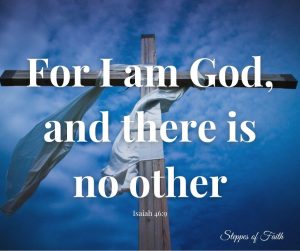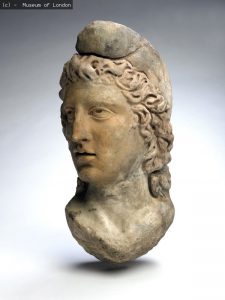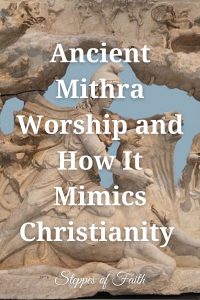
“For I am God, and there is no other.” Isaiah 46:9
During the time of the Medes and Persians, the people of the region worshiped a god they called Mithra.
The ancient god first began in approximately 3,000 B.C. with the Indo-Iranian and Indo-Aryan people. They practiced the polytheistic Early Iranian Religion, where Mithra played a central role. Mithraism became very popular in Iranian and Indian cultures from 700 B.C. to 651 A.D. It slowly morphed into a monotheistic religion called Zoroastrianism, created by a magi (priest) named Zoroaster. Eventually, the Roman Empire also accepted Mithra, especially Roman soldiers who often prayed for the god to protect them in battle.
According to Persian history, Mithra was the god of the rising sun, of contracts, covenants, and friendships. Through his power, he controlled the changing of the seasons, kept things in cosmic order, ruled the rise and fall of kings, and protected his followers. Riding a chariot drawn by white horses, Mithra brought up the sun every morning as he carried a silver spear, a gold bow and arrow, daggers, and axes. Most especially, he carried a mace that proved his authority.
Zoroastrian scripture, called the Avesta, describes Mithra this way:
“He who first, of the heavenly gods, reaches over the Hara [Alburz Mountains], before the undying, swift-horsed sun; who, foremost in a golden array, takes hold of the beautiful summits, and from thence looks over the abode of the Aryans [Iranian peoples] with a beneficent eye (Yasht 10.13, as cited in Curtis, 14)”
The Romans interpreted Mithra to be born from a rock while holding a torch or shooting an arrow into a cloud that then rains water. The rain is why some considered him to be the god of life and fertility. He is also depicted as slaying a celestial bull, which is interpreted as a symbol of death and rebirth.
While Zoroastrianism/Mithraism is an ancient religion, it is not dead. Some people in India still practice it today. How did this religion manage to take an ancient idea and form it into a once widely popular deity? And how has it influenced modern Christianity?

Mithra, Museum of London
Mithra and Zoroastrianism
In response to the increasingly popular Persian Mithra, the priest Zoroaster established his own form of Early Iranian Religion after he received a vision that the people’s spirituality had gone astray. He concluded that there were not many gods, as the Early Iranian Religion taught, but only one god, and it was not Mithra. Zoroaster named it Ahura Mazda.
Zoroaster’s claims and teachings initially became known as Mazdaism and, later, Zoroastrianism, and many people embraced it. The Babylonian Empire, which encompassed Iran and northern India, allowed Zoroastrianism to take a firm cultural foothold, including during the time of Esther and the biblical prophet Daniel. Some assert that King Darius, who saved Daniel from the lion’s den in Daniel 6, may have been a follower of this religion.
Others have concluded that Persian King Artaxerxes also was a follower during Nehemiah’s time. It is rumored he often invoked Mithra’s protection (as well as from others). Some believe he may have not been a true follower of Zoroastrianism but only believed Ahuda Mazda was the one true god, and that Mithra was a protective derivative of it.
Because of its popularity, Zoroastrianism soon found itself in contention with Christianity. An enormous number of beliefs of both religions overlapped, causing confusion and a fight for souls among devoted followers. In examining Zoroastrianism, we can see why. We also see how this ancient pagan religion has influenced modern Christianity.
Mithra vs. Jesus
Individual tenets of both Zoroastrianism/Mithraism and Christianity are strikingly similar, though some vary depending on which version of Mithraism one follows. Not all followers believe the same things. Some of the more common similarities are:
- Mithra and Jesus were both born of a virgin
- They were both visited by magi soon after their births
- They both mediated between heaven and earth
- Both are called “the light of the world”
- Both promoted baptism of their followers (although Mithra’s baptism was quite violent and bloody)
- Followers mainly worshiped on Sundays
- Both had twelve disciples
- Both are all-seeing and cannot be deceived
- After they finished their work, they both ate a “last supper” with their followers and ascended to heaven
- Both will judge good from evil on the Day of Judgment. Mithra, who controls the “Chinvat Bridge” where souls are judged, will read a record of deeds to determine one’s destination after death. Those who Mithra found to be faithful followers were sent to the House of Song while those who were not were sent to the House of Lies. Countless prophecies about Jesus and the Tribulation can be found throughout the Bible including Daniel, Thessalonians, Isaiah, Revelation, and the four Gospels.
One striking parallel in both faiths concerns when Mithra and Jesus were born. We do not know the date of Jesus’ birth, though many speculate He likely was born in the Spring. Still, Christians around the world commonly celebrate His birth on December 25. Followers of Zoroastrianism firmly believe Mithra was born on December 25.

The Establishment of December 25
Christianity was not initially popular in the Roman Empire. Instead, as a part of their polytheistic culture, many Romans celebrated the rebirth of the sun god Sol Invictus. This commemoration followed the winter solstice celebration of Saturnalia, during which people exchanged gifts and held special feasts.
However, after Emperor Constantine came to power in 306 A.D., he, along with Licinius, issued the Edict of Milan, which established Christianity as the official religion of the empire. But many continued to believe in multiple gods. As a result, though Christianity flourished and spread throughout the empire, polytheism began to influence Christian beliefs and traditions.
In 336 A.D., the church in Rome officially declared December 25 as the day to celebrate the Lord’s birth. Some believe it was a political move Constantine made to weaken the allure of pagan festivities, but this is speculation. We have no evidence that confirms the practice of celebrating Mithra’s birthday on December 25 as the reason why Christians celebrate Christ’s birth on the same day.
But we do know many people rejected the date of December 25 for another fifty years, instead choosing to celebrate Christ’s birth on January 6. It was not until the ninth century that Christians adopted December 25 as the official day of celebration. January 6 is now regarded as the day of Epiphany, the day the wise men visited Mary, Joseph, and baby Jesus.
Those who still practice Zoroastrianism maintain that Christianity copied their belief system, but one thing is certain. Christianity is not a copy of Zoroastrianism, and Jesus is not based on Mithra. Early Christian sources as well as archaeological, geological, and biblical evidence overwhelmingly support this truth.
Followers of the God of the Bible pre-date Zoroastrianism by thousands of years. We see evidence of this in the book of Genesis with the stories of Abraham, Noah, and Moses, and writings from early church historians such as Josephus. Geological evidence also points to Noah’s flood occurring almost 5,000 years before the invention of Mithra.
Even Mithraic texts are dated well after Christianity took hold in the Roman Empire.
The Rise of Atheistic Philosophy
As belief in Mithra began to diminish over time, two French academic philosophers in the late 1700s—Charles Francois Dupuis and Constantin Francois Chasseboef de Valnay—popularized their claim that Jesus is a myth and Christianity is based on Zoroastrianism. Others later claimed that Mithra is the model for the creation of a character named Jesus. The idea was formally called the Christ Myth Theory after it was published in Dupuis’ The Origin of All Cults in 1794.
The theory grew in popularity during the French Revolution when many walked away from their Christian faith, demonizing it, while atheists and non-Christian writers continued promoting it. Yet, we know all of it—from the Early Iranian Religion to the Christ Myth Theory—are all lies coming straight from the author of lies himself.

Only One True God
Satan has been trying since the time of Adam and Eve to draw people away from the truth. He works tirelessly to make people believe that God is not the one true God and Jesus is a mythical character. But we who are justified by faith know the truth.
The Bible clearly tells us there is only one true God.
“I am the LORD your God. You shall have no other gods before Me.” Exodus 20:2-3
“The LORD our God, the LORD is one!” Deuteronomy 6:4
“For I am God, and there is no other. I am God, and there is none like Me.” Isaiah 46:9
“Have we not all one Father?” Malachi 2:10
“There is one God who will justify the circumcised by faith and the uncircumcised by faith.” Romans 3:30
“You believe there is one God. You do well. Even the demons believe and tremble!” James 2:19
Mithra Won’t Get You to Heaven
The similarities between Zoroastrianism and Christianity are easy to see. A notable difference, however, is how one attains eternal life.
Much like Buddhism, followers of Mithra and Zoroastrianism frequently practiced divination and pursued enlightenment of one’s soul. Rebirth after death was the main goal. Followers went through a number of trials during each life. As each trial was successfully achieved, they were elevated up a hierarchy of seven levels until they reached the highest of “Father.” A Father was regarded as an enlightened and protective priest figure.
Christians, on the other hand, know they have the promise of eternal life simply by accepting Jesus’ gift of grace. He has already done the work for them through His sacrificial death and resurrection. Multiple levels of enlightenment are not necessary since we are instantly with Him when we die (2 Corinthians 5:8, “absent from the body, present with the Lord”).
Christians have many dependable reasons to put their full faith in God and not a false, man-made god.
Today, people still celebrate the festival of Mithrakana (also called Mithragan) in Mithra’s honor during the autumn equinox. He continues to be a symbol of light and order for his followers. But believers in Jesus Christ know there is only one true God in heaven, and there is only one Savior (John 1:1). There is only One truly worthy of worship.
The Bible is clear about what happens to anyone who believes or worships otherwise: They will be thrown into the lake of fire to endure eternal suffering and separation from Him (Revelation 21:8; Matthew 25:46; Luke 16:19-31).
